In line with market pricing and virtually unanimous expectations among forecasters (ourselves included), the UK MPC raised its policy rate by 25bps to 4.50% today, marking the 12th consecutive rate hike. As has been the case for each of these decisions, votes were again divided: two MPC members, Silvana Tenreyro and Swati Dhingra, opted to vote for leaving rates on hold, whereas the remaining seven members sided with +25bp. For the two doves, it is the fourth consecutive meeting at which they would have preferred steady rates rather than a further hike.
Underpinning the decision was the latest Monetary Policy Report (MPR). Its most eye-catching feature was an upward revision to the GDP projections. Having envisaged a recession for five consecutive quarters (Q1 2023 to Q1 2024 inclusively) in the February MPR, the latest forecasts no longer anticipate a contraction at all, instead forecasting zero growth for H1 2023 and then (historically moderate) rises in output, even as much of the lagged effect of the MPC’s previous rate rises is yet to come through. The key reason for these forecast revisions is the unexpectedly large unwind of the past year’s surge in wholesale energy prices, which makes for much less of a drag on output than previously factored in. Importantly, the Bank also judges the impact of the banking sector turmoil on credit conditions in the UK as likely to be ‘only […] small’. Positive effects from the Budget, and improved global conditions were also mentioned, as was generally greater resilience in economic momentum than anticipated.
Meanwhile, despite the lower energy price outlook, and despite basing its forecasts on higher interest rate assumptions than in the last (February) MPR, the Bank lifted its inflation forecasts visibly. Its new baseline projections still see inflation falling well below target. But this is now expected to apply from Q1 2025 onwards rather than Q2 2024; and the degree of the shortfall is reduced (Q1 2026 inflation is now seen as +1.1% rather than +0.4%). To some extent this is counterintuitive: an unwind of the energy shock would normally be expected to lead to improved growth but also lower inflation forecasts. That it didn’t in this case reflects the Bank’s concerns regarding asymmetry and longer-lasting second-round effects in wage setting – or, as the Bank put it, inflation persistence, leading to perceived upside risks: Andrew Bailey emphasized that the mean inflation forecast is well above the mode (at 1.9% in Q1 2026, well above the 1.2% forecast in the February MPR).
A lot of the discussion centred around the near-term disinflationary path being seen as slower than beforehand, largely as falls in wholesale food prices are now projected to take longer to filter through to consumers. Even so, this is unlikely to be a material influence on inflation towards the end of the forecast horizon, in early 2026. Governor Bailey stated explicitly in the press conference that he was not seeking to give a directional steer on policy rates, and that future decisions would be evidence-driven. Still, that the Bank now has a mean medium-term inflation projection that is not too far from target suggests it sees the assumed path of policy rates – which had a peak in rates of around 4¾% in 2023 Q4 and falls to just over 3½% by early 2026 – as broadly appropriate. Our own sense is that the Bank may now have become overly cautious regarding the speed at which inflation will fall. If the data bear this out, room for rate reductions may open up sooner than the MPC currently thinks. Our base case remains that, with today’s hike, rates have now peaked, and rates will be cut again from November. But we acknowledge that, prior to this, one or possibly two more rate hikes could yet take place in the interim.
Get more FX market insights
Stay up to date with our FX insights hub, where our dedicated experts help provide the knowledge to navigate the currency markets.
Previous Quickviews

Budget 2023 reaction – Hunt places faith in supply reforms
16 Mar 2023
Jeremy Hunt, the UK's fourth Chancellor in the past 12 months, delivered his first Budget yesterday. Despite the rapid turnover of his predecessors, the latest exercise has a strong theme of continuity about it. Mr Hunt's tenure last autumn began with a die-hard attempt to stabilise the public finances and with them, UK financial markets, which were in panic mode thanks to the substantial giveaways announced by the previous Chancellor Kwasi Kwarteng. Yesterday's Budget was an attempt to deliver long-term sustainable economic growth via a number of supply-side measures including new investment allowances, more assistance with childcare costs and scrapping tax-free limits on personal pension pots to discourage early retirement. Of course the Chancellor grabbed as many short-term political brownie points as he could through measures such the extension of the £2500 Energy Price Guarantee for three months, a further freezing of fuel duties and draught beer relief for pubs.
Mr Hunt has benefited from a more benign economic environment – confidence globally since November's mini-Budget has improved materially. UK GDP forecasts for this year and next have been upgraded. Moreover although the economy is expected to contract by 0.2% in 2023, it is no longer thought by the OBR to enter a technical recession this year. This has led to an improved background for the public finances, including a kinder interest rate profile. For example, the OBR now forecasts borrowing (PSNBx) to be £152bn this financial year (from £177bn last), with a moderate reduction in the forecast next year. Projected debt servicing costs have also been lowered in each of the next six years. The Chancellor is still on course to meet his main rule, the fiscal mandate, but with an even smaller margin than envisaged in November. In fact at £6.5bn, Mr Hunt has the lowest amount of headroom since the Conservatives took power in 2010 and the OBR was established.
Overall the Chancellor should be applauded for attempting to tackle the UK's structural weakness by focusing on long-term supply side measures. But issues such poor productivity growth and high labour inactivity rates are intrinsically entrenched. Indeed labour productivity has been a 'puzzle' since the aftermath of the financial crisis over the past decade or more. The OBR assesses that the new labour supply measures will add some 110k to the labour force by the end of the projection. This however compares with an increase in inactivity of 488k from the pre-pandemic trough, more of which is seen as structural than previously. In short today's measures are welcome though they are far from a silver bullet to ease the economy's woes. But if things go well over the next year, the Chancellor will enter the next phase of his fiscal strategy, which will be to find room for a tax giveaway ahead of a likely 2024 election.
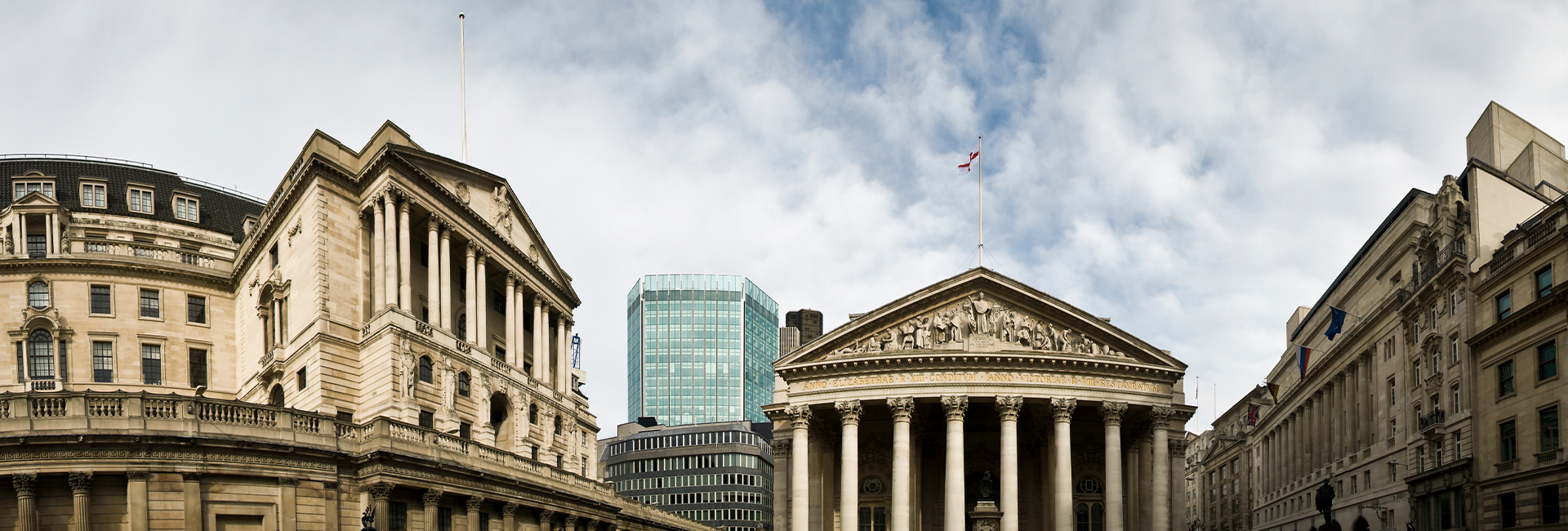
MPC reaction: 50bp hike driven by the risks, rather than the data
03 Feb 2023
Why did the MPC hike by 50bps at this week’s meeting? Upside risks to inflation have focused minds at Threadneedle Street – especially those caused by the labour and energy markets.
The Bank of England’s Monetary Policy Committee kicked off the New Year with a further 50bp increase in the Bank rate to 4.00%, in line with consensus expectations, although we expected a smaller increment hike of 25bps. As was with the December vote, there was dissent among the committee, with MPC members Swati Dhingra and Silvana Tenreyro once again voting for an unchanged Bank rate. In all, it certainly was a dovish 50bps hike, which was demonstrated in the market reaction. On immediate release, sterling jumped pushing cable close to $1.24. However as market participants digested both the accompanying minutes and the Monetary Policy Report (MPR), those gains quickly unwound, with GBPUSD currently trading at $1.2317 after hitting a low of $1.2265. We saw similar volatility in UK sovereign bond markets. As of writing 10Y gilt yields are trading at 3.05%, around 25bps lower on the day. Markets seemed to quickly dismiss the half-point rate hike as focus turned to if the Bank of England could be reaching – or even at – the end of the tightening road, although there was also a dovish market reaction in global markets to today’s ECB news.
With central bank communication it is often not just what was said, but also what was not said. We believe this is one reason for the dovish interpretation of the minutes. There were two changes to the guidance. First, the minutes no longer said that if the economy evolved as expected, further increase in Bank Rate might be required. Second, they suggested that if there was evidence of more persistent inflation pressures, ‘further tightening in monetary policy would be required’ dropping the phrase ‘responding forcefully’. Reading between the lines, all of this points to a MPC that that is less sure on the need for further rate increases.
The accompanying projections could suggest that a pause in tightening (and even cuts this year!) may be appropriate. If interest rates were to evolve as markets are expecting, then on the Bank of England’s central case forecasts, this would see headline inflation dropping below the 2.0% target in Q2 2024 and finishing the forecast horizon approaching deflationary territory, at just 0.37%. The economic growth outlook is equally uninspiring. Although the Bank of England no longer forecasts the eight-quarter recession that it did back in November, this is at least partly a result of a lower yield curve on which the new projections are conditioned. On the basis that the peak in rates is around 4.5% (around 75bps lower than in November’s MPR), the Bank sees a five-quarter recession, starting in the current quarter. It does not expect a booming economic recovery after either, with the forecasts suggesting that the UK economy will be smaller at the end of the forecast horizon than it was in 2019.
The question therefore is, why did the MPC hike by 50bps at this meeting? The minutes and Governor Bailey’s press conference made it clear that it was the upside risks to the inflation projections that drove the majority on the committee to vote for a 50bp hike. Indeed, as Governor Bailey emphasised multiple times in the press conference, inflation risks are more skewed to the upside than any time in the MPC’s history. These upside risks seem to stem from two key areas: the labour and energy markets.
On the labour market, the Bank is concerned that the current tightness of the labour market could still induce higher wage growth, and that this will translate into even more sustained services inflation, a fear shared with the Federal Reserve. This risk seems to have intensified due to the recent bout of higher-than-expected wage growth relative to the Bank’s November forecast and also as a result of the Bank’s decision to downgrade its labour market participation rate projection. It now sees a more subdued participation rate beyond the end of the forecast period, limiting labour supply. Meanwhile, for energy, embedded in the Bank’s inflation forecasts is that energy prices develop as per the futures curve, which have flattened quite starkly recently. If, in contrast energy prices remain at their current levels, the Bank of England estimates that CPI inflation could be nearly 1%pt higher in three years’ time.
Even under this scenario, as per the Bank of England’s own forecasts, CPI inflation would still be below its 2.0% target, however. Furthermore, although wage growth was stronger than envisaged in the November report, the minutes did note that there had been ‘tentative indications of pay pressures moderating over the year’. It is the uncertainty over whether the upside risks to inflation will crystallise that begs the question of where policy may move next.
In the press conference Deputy Governor Ben Broadbent presented his view that what had been presented today did not necessarily imply that the Bank rate has reached the peak. We would agree with this. Although the forecasts present a lacklustre economic outlook, with inflation below target by the middle of the forecast horizon, this has to be balanced against the clear concern on the committee that inflation could prove to be more persistent than its forecasts would suggest. The minutes themselves say that a greater weight has been put on the recent strength in labour market and inflation data and ‘relatively less on the medium-term projections’. As such, assuming this approach applies moving forward, we would be inclined to the view that this is not the end just yet, and collectively the MPC has one more 25bp hike left in them in March, taking the terminal Bank rate to 4.25%.
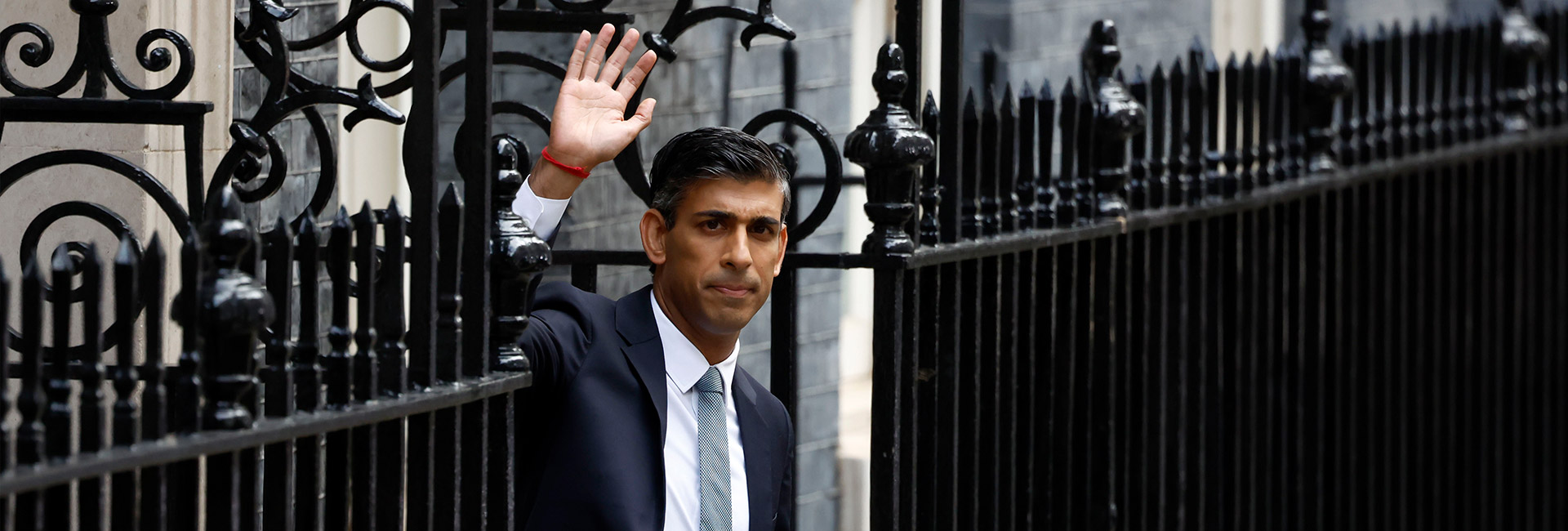
Can Sunak soothe the markets?
26 Oct 2022
Rishi Sunak has inherited a daunting in-tray as the UK’s new prime minister, including high levels of inflation, the potential for recession, a growing energy emergency and the cost-of-living crisis. What does the new PM need to focus on to regain the trust of the markets? Investec Chief Economist Phil Shaw and Head of Investment Strategy John Wyn-Evans discuss in our latest ‘No Ordinary Wednesday’ podcast hosted by Jeremy Maggs.
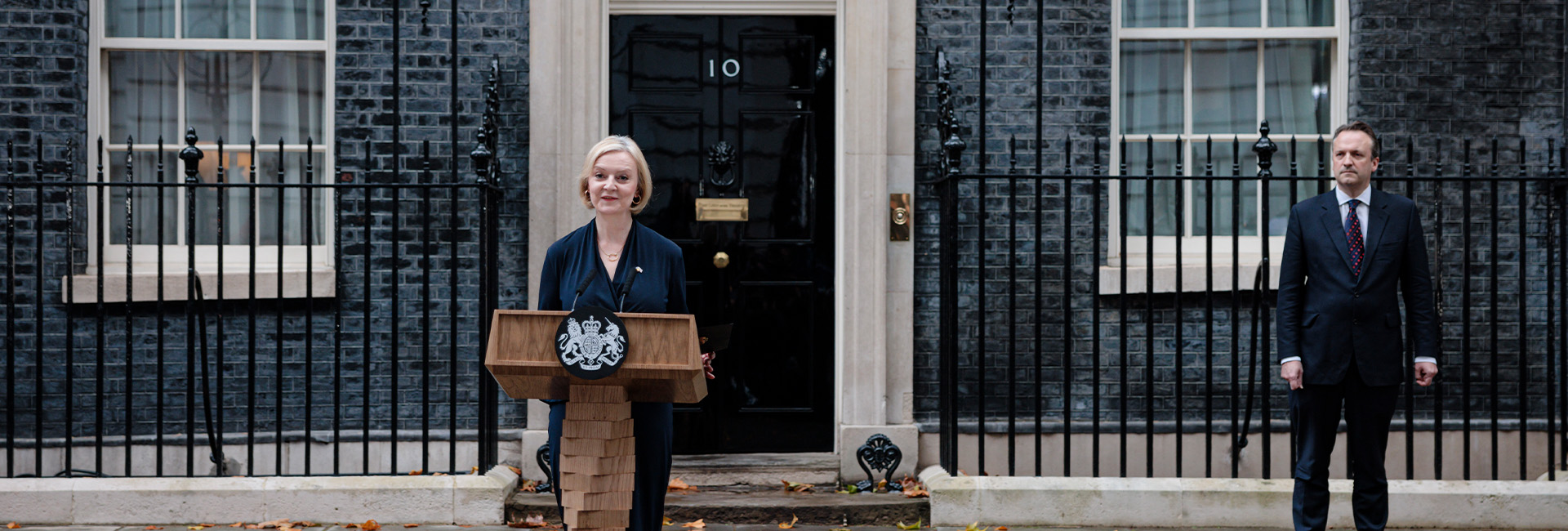
Britannia un-Trussed – Britain heads for third PM this year
20 Oct 2022
Following a chaos-strewn 45 days as prime minister, Liz Truss stood down today, stating that she could not deliver the mandate on which she was elected by Conservative Party members. Indeed, even the past week has been filled with turmoil, starting with the sacking of Chancellor Kwasi Kwarteng last Friday and culminating yesterday in the departure of Home Secretary Suella Braverman and total confusion among Tory MPs in the House of Commons over a vote on fracking.
By contrast with the political situation, conditions in markets have calmed down over the past week or so. At the time of writing, ten-year gilt yields are 43 basis points lower since last week’s close and 30-year yields down 81 basis points – helped by the Bank of England stating that for now, it will not sell gilts of more than 20 years’ maturity in its Quantitative Tightening operations, which it plans to start from 1 November. Sterling is also a touch higher, at $1.1260.
The critical point here is that new Chancellor Jeremy Hunt acted quickly to reassure markets on Monday morning, making it clear that he would jettison almost all of Kwarteng’s unfunded tax cuts, saving £32bn per annum. He also announced that Truss’ plan to freeze the domestic energy price cap at £2,500 would be curtailed from two years to six months, with a (yet to be decided) more targeted scheme to replace it in April next year. Furthermore, Hunt stated that additional painful decisions need to be made both in terms of taxation and public spending.
The Budget on 31 October has therefore become a critical event. Interest rate markets have rallied to price in a lower peak in the bank rate, from 6.25% in late September to a touch above 5.00% now, but after the events of the past month and a half, the reputation of the UK remains on the line. While credibility is easily lost, it can take a very long time for it to be regained. In this respect, markets will consider it essential for the chancellor to be able to carry through his plans to bring the UK back on course to meet its fiscal rules.
The party intends that the leadership contest is completed by 28 October. It has also been indicated that the full party membership will be involved. The rules of the contest have yet to be made public but our suspicion is that a high bar in the number of supporting MPs will be needed for a potential candidate to enter the contest. Indeed, Chairman of the 1922 Committee Sir Graham Brady conceded it was possible that only one candidate might emerge. We note that the bookmakers’ favourite is former Chancellor Rishi Sunak who came second to Liz Truss in the vote among members, but who topped the poll among Conservative MPs. However, other names such as former PM Boris Johnson have also been mentioned.
In short, further information will emerge in due course, and the situation is very fluid. However, it should be noted that the Tories are on the backfoot and on average trailing Labour in the polls by around 30 percentage points. Hence, we would expect the party to try to paper over the cracks of its own disunity in order to avoid potential electoral annihilation. The next general election is not due until 2024, which the party will hope will give it time to turn public opinion around.
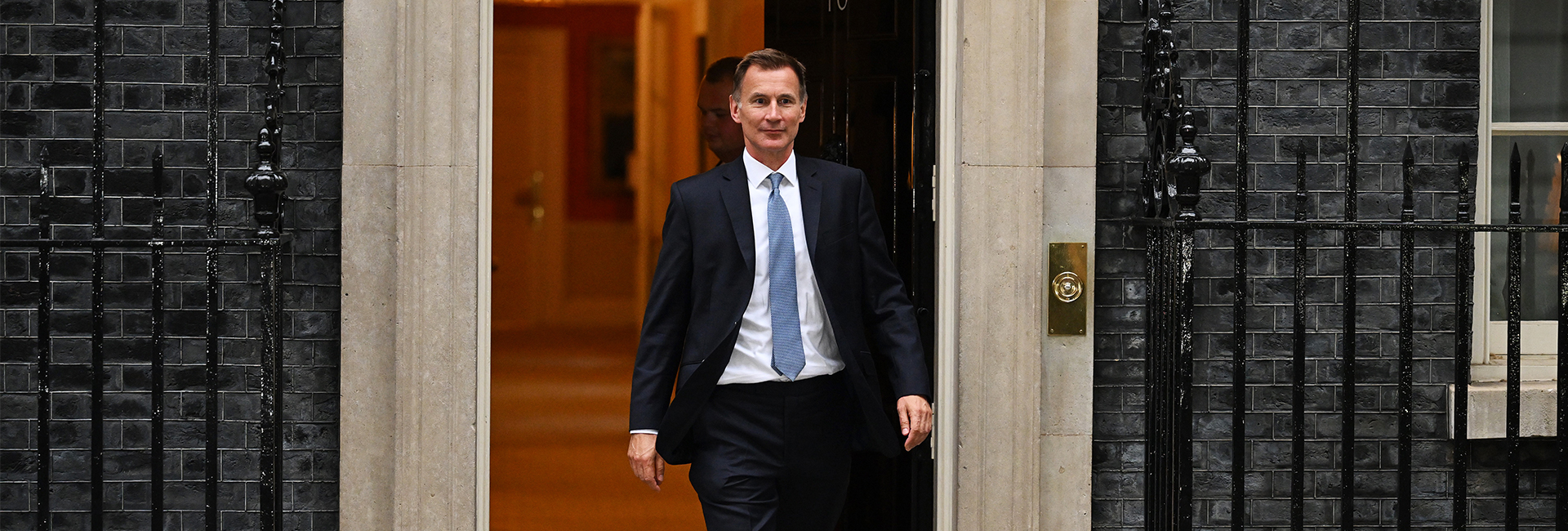
Goodwill Hunt-ing: New UK chancellor reassures markets
17 Oct 2022
Today, newly appointed Chancellor Jeremy Hunt – in this role only since Friday – announced a major reversal by the government on planned fiscal measures. The timing of this announcement was no doubt influenced by the desire to reassure markets, now that the Bank of England has stepped away from its temporary gilt purchases and with the upcoming ratings review of the UK by ratings agencies S&P and Moody’s on Friday this week, ahead of the 31 October Medium-Term Fiscal Plan. In the prime minister’s confrontation with ‘economic orthodoxy’ – derided by Liz Truss in her leadership campaign – the need for ‘stability’ (read: orthodoxy) has won out with a vengeance.
In essence, as Chancellor Hunt made clear, the government has conceded a reversal of almost all the tax measures that had been announced by his predecessor Kwasi Kwarteng in the 23 September ‘Growth Plan’. This includes the planned cut by one percentage point to the basic rate of income tax from April 2024. Indeed, this is now not only not being brought forward to April 2023 but in fact shelved ‘indefinitely’ – until economic conditions allow. This is a reversal not only of Kwarteng’s plans but also Rishi Sunak’s, and keeps an extra c.£6bn a year in the government’s coffers.
Out of the measures proposed on 23 September, it is only the reversal of the 1.25 percentage point rise in National Insurance contributions that took place this April with effect from 6 November, as well as the permanent rise in the stamp duty threshold to £250,000 (and for first-time buyers, to £425,000), that remain untouched. The first of this comes at a net cost of c.£15bn annually, as per the government’s own estimates, whereas the latter foregoes around £1.7bn of annual revenue. This compares to an original long-term annual price tag for all measures proposed on 23 September of c.£45bn. In total, Chancellor Hunt indicated the government is to retain c.£32bn annually of revenues through these changes.
However, this is not all. A major plank of the government’s support package was a universal utility unit price cap from October for two years at the household level, at a cost our utilities analysts put at c.£90bn. This has now been pared back significantly, to be universal only for the six months to April 2023 (at a cost of c.£31bn). Thereafter, a new approach is to be designed that ‘will cost the taxpayers significantly less than planned while ensuring support for those most in need’. To us, this sounds like a means-tested payment in some form will be put in place. Businesses, meanwhile, who were given a similar unit energy price cap for six months from October (at a cost of c. £29bn), are still receiving this support; but they too remain on notice that help afterwards will be for those businesses ‘most affected’ only – something that the 23 September Growth Plan had indicated as well. Energy efficiency now got a mention, for the first time, as being ‘better incentivised’ this way.
With leaks suggesting the Treasury will now have to find as much as £60-70bn to plug the gap in government finances, according to interim Office for Budget Responsibility estimates, the measures proposed today are significant. But even then, they are far from enough. This is yet to be confirmed – most likely at the 31 October statement. Still it is probably what prompted the Chancellor to warn that ‘more difficult decisions’ on tax and spending are to come.
One point of uncertainty concerns the status of energy guarantees to households, given that the £2,500 price cap now ends in April next year. Our Utilities team estimates that the price cap at that point could rise to £4,300 (given the current structure of gas futures prices). If so, this would necessitate some sort of further support to the household sector, at a further fiscal cost, even if it is more targeted and not universal. A second point is that the £2,500 price cap fed directly into the Consumer Price Index profile for two years (as it was classified as a price cut). Any replacement policy from next April is likely to be more modest and could in any case be a subsidy to incomes, which would not be classed as a price cut. The inflation profile over the ensuing 12-18 months or so is thus likely to be higher. But we will have to see exactly what the replacement for the Energy Price Guarantee is before making a firm judgement.
By unwinding the majority of the ‘mini’-Budget, the new chancellor has attempted to restore credibility to UK fiscal policy and his prompt intervention illustrates how seriously he is taking it. S&P recently placed the UK’s AA rating on a negative outlook, while Moody’s (Aa3) remarked that recent fiscal events were ‘credit negative’. Hunt may well have done enough to prevent a formal downgrade at the end of the week. Indeed gilts have extended this morning’s gains. Ten-year yields are now trading 40 basis points lower on the day at 3.92% and 30-year conventionals at 4.35%, 80 basis points down from their peak during the LDI pensions storm towards the end of September. Sterling has held onto the day’s gains at $1.1290.
The OBR will publish its assessment of the economic and fiscal outlook alongside the Budget on 31 October. At that point, further fiscal tightening measures to get the debt to GDP ratio on a downward path over the medium-term are almost certainly going to be forthcoming. Of course reducing the scale of the Energy Price Guarantee only has a material impact on the public finances until October 2024, since it was scheduled to end then (although the Exchequer will also save the debt servicing costs through the reduction in its cost over the longer-term).
While we do not yet have a complete picture of fiscal policy, the chancellor has acted quickly and decisively, and this has received a thumbs up from markets. As a consequence, the fiscal policy stance looks set to be considerably tighter, and we are reviewing our macroeconomic forecasts, including for interest rates. Our initial thought is that the growth outlook may be weaker, but this could be tempered by the bank rate potentially not needing to rise as far as our current forecast of 5% early next year.

No slack in UK labour market as BoE intervenes again
11 October 2022
Labour market conditions remained extremely tight in August, as was confirmed by data released by the ONS this morning. Indeed, the unemployment rate ticked down to 3.5%, whereas consensus and Investec expectations were for the rate to hold steady at 3.6%. This marks the lowest unemployment rate since 1974. There are few signs that conditions were any looser in September either, with the timelier measure of payrolled employees increasing by 69k on the month. Although vacancies have clearly passed their peak, at 1.25 million these are still historically high – for comparison vacancies averaged at around 825k across 2019.
One key reason why the labour market is currently so tight is due to the sharply lower participation rate relative to pre-pandemic levels. Indeed, in the three months to August, economic inactivity was at 21.7%, 1.5%pts higher than in the three months to February 2020, prior to the pandemic. Over a quarter of those classed as economically inactive attributed this to long-term sickness, which, at 2.5 million people, hit a record high in the three months to August.
Of particular concern to the Bank of England would be the wage numbers. These surpassed consensus expectations, with growth in average total pay (including bonuses) hitting 6.0% year-on-year in the three months to August and 5.4% excluding bonuses. Considering the winding down in the furlough scheme in the summer of last year, the furlough-induced distortions in this data have now largely filtered out, making the wage growth numbers a more representative indicator of current pay pressures. As such, the Bank of England is likely to take note of the fact that regular pay (excluding bonuses) hit the strongest growth rate seen outside of the pandemic period, raising concerns of a potential wage-price spiral, which would keep inflation higher for longer.
The ultimate message from today’s report is that the labour market remains extremely tight, propping the door open for further hikes by the Bank of England. Still, it is not this report that is likely to fundamentally alter the collective thoughts on the Monetary Policy Committee (MPC) ahead of November’s meeting. Indeed, of much greater focus is likely to be the impact of Kwasi Kwarteng’s medium-term fiscal plan.
Yesterday it was confirmed that the publication of the chancellor’s medium-term fiscal plan would be brought forward to 31 October, providing the MPC with a full set of information – including the independent analysis by the Office for Budget Responsibility – on the government’s intended fiscal stance prior to the next policy decision. Given that the fiscal expansion is likely to be inflationary over the medium term, we believe the MPC will have to respond with an outsized hike. How large this interest rate increase will be is highly uncertain, however. Markets are currently pricing in a November rate hike of over 100bps. Considering that prior to this tightening cycle, the MPC had never hiked by a larger increment than 25bps, and in this cycle, so far, the committee has taken a more gradual approach to tightening than its peers at the Federal Reserve, the Bank of Canada and the European Central Bank, we think it will opt for a smaller – but still unprecedented – 75bps hike. However, recent history has taught us never to rule anything out.
Although the shift forward in the timing of the Budget was welcomed, market volatility – particularly in the UK government bond market – was substantial yesterday. UK gilt yields rose by around 25-30bps across the curve, with the early Bank of England announcement yesterday morning to smooth the transition from the end of the gilt purchasing operation on Friday (14th) doing little to soothe markets.
Much focus has been on longer-dated conventional government bonds, as that had been the subject of the bank’s bond buying operation, yet we have also seen a sharp pick-up in index-linked gilt yields. Yesterday the 10Y index-linked real gilt yield rose by over 60bps in a single day. With the aim to maintain market stability, the Bank of England responded to this movement by announcing this morning that it would widen its gilt buying operation to include the purchase of index-linked gilts. This will be up to a value of £5bn per day, alongside the £5bn per day of long-dated conventional gilts, totalling a maximum gilt stock purchase of £10bn per day, the increased amount announced yesterday. This is a clear shift in direction in response to financial stability concerns, as, throughout the entire time when the BoE has conducted quantitative easing, it has never to date purchased index-linked bonds.
It should be noted however that thus far the bank's purchases have fallen far short of the maximum amount pledged: yesterday only £853m of longer-dated gilts were purchased, despite the sharp pick-up in yields, and £263m of offers were rejected. A further point of this morning’s announcement is the recognition by the Bank of England that it is not just government bonds that have come under pressure as of late, but also corporate bonds. To help alleviate market woes, the Bank of England has decided to temporarily pause corporate bond sales this week.
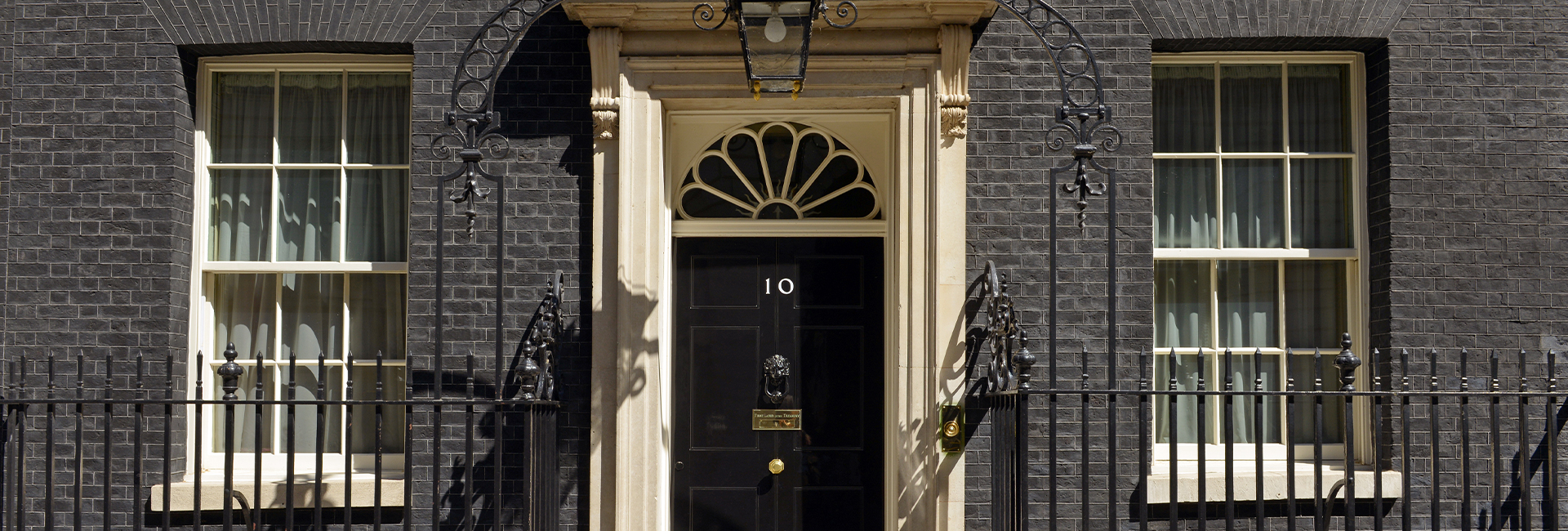
A second U-turn by the government
4 October 2022
Following the news yesterday that the government will abandon its plan to lower the top rate of income tax from 45% to 40%, the government has made a further concession. Instead of revealing its medium-term fiscal plan with a full OBR assessment on 23 November – which itself had been announced only on Wednesday 28 September in response to the fallout from the mini-Budget spiralling – this timetable will be brought forward, according to numerous press reports. No exact date is confirmed as yet, but publication is now expected later this month.
This news has reinforced the rebound in sterling. Indeed, having climbed through yesterday, cable is currently trading above $1.13 and GBP below 87p against EUR, meaning GBP has reversed all of its losses against these two major currencies since the announcement of the mini-Budget on 23 September. The same cannot be said for bond markets, which to date have yields remaining well above their levels of 23 September. Still, the Bank of England has been able to scale back its gilt purchases with maturities of over 20 years, purchasing as little as £22m worth of bonds yesterday out of a total maximum of £5bn it had allowed itself per day. It is also now requiring banks to identify whether they are entering offers to sell bonds at daily auctions on their own behalf or on behalf of clients, ‘in order to ensure the backstop objective of the tool is delivered’. This can be seen as a warning that the Bank is trying to keep interventions to the minimum necessary so as not to compete with its wider objective of reining in price pressures. With the publication of new fiscal forecasts now set to come ahead of the next monetary policy meeting (3 Nov), this will indicate how far the MPC is willing to go to curb demand at a time when government policy is to boost growth.

Bank of England steps in as UK pension funds struggle
29 September 2022
This week has seen continued turmoil in financial markets, culminating yesterday morning in the Bank of England acting with an (up to) £65bn emergency intervention, in an attempt to calm domestic markets and restore financial stability. This was in response to the reaction in longer-dated gilt markets – particularly at the 30-year maturity – to Chancellor Kwasi Kwarteng's mini-Budget.
The biggest tax-cutting spree in 50 years, to be funded by extra borrowing, the mini-Budget been questioned considering the backdrop of spiralling inflation, and markets have let their feelings be known. 30-year gilt yields surpassed 5% early yesterday morning, the highest since 2002.
This had stark ramifications for defined-benefit pension funds, which experts suggest was the tipping point for the Bank of England to intervene. Although higher yields are typically not a problem for pension funds (the opposite, in fact, with higher yields prompting more returns), the sheer extent of the move was.
The sharp decline in the value of the longer-dated gilt (yields and prices move in opposite directions to each other) has caused issues with the fact that £1-1.5trn of pension funds liabilities are covered by so-called liability-driven hedging strategies. These hedging strategies experienced sharp losses as a result of the market rout, meaning that pension funds faced margin calls to cover these losses.
To raise the cash to satisfy these, the pension funds were forced into selling some of their assets, particularly longer-dated gilts. In turn, that pushed gilt yields higher still and set off a vicious cycle. Ultimately, the fear was that this could get out of hand and force pension funds to collapse due to liquidity problems.
As such the Bank of England stepped in, which seemed to have the desired effect, pushing down gilt yields at the long end of the curve. 30-year gilt yields have fallen to 3.93%, an intra-day swing of well over 100 basis points.
The quantitative easing has had the desired effect, but it only buys time to deal with liquidity issues. We question what will happen come 14 October, when the Bank of England has said this bond-buying spree will end. Under the bank's new plans, the delayed active selling phase under its quantitative tightening programme should begin at the end of October.
The trigger for the domestic financial market volatility seems to be the chancellor's fiscal package, but as of yet the government seems committed to ride out the storm, with no U-turns in sight.

Sterling badly hurt in the mini-Budget fallout
26 September 2022
UK Chancellor Kwasi Kwarteng’s super-sized mini-Budget, in which he revealed on Friday a series of unfunded tax cuts on top of the energy bill support for households and non-domestic customers, was met with evident disapproval in financial markets: bond markets sold off, as did sterling.
The size of the moves was huge, making clear how strong that signal (and the surprise) was: 2-year yields rose by 38 basis points on the day on Friday, 5-year yields by 45 basis points and 10-year yields by 31 basis points. The pound was down by 3.2% against the US dollar to $1.09 and weakened 2.1% against the euro to 89p.
Instead of reassuring markets, in an interview on Sunday, Chancellor Kwarteng chose to flag his intention to cut taxes even further over the coming year. The reaction in markets this morning has been to double down too, with sterling temporarily plunging to an all-time low of $1.035 against dollar.
This may test the chancellor’s resolve ‘not to comment on market moves’. Moreover, it puts the Bank of England in an awkward bind: a weaker currency adds to inflation pressures, suggesting more monetary tightening is needed; but additional rate hikes will necessarily weigh on growth and directly counteract the government’s stated aim to boost trend growth. Even so, there are increasing calls from some market observers, and indeed from some previous Monetary Policy Committee members, for an emergency rate hike as soon as this week.
Perhaps most challenging of all, from the chancellor’s perspective, is that the surge in longer-date bond yields also adds to the cost of servicing government debt, absorbing tax revenue for this rather than public services or growth-enhancing investments. We are currently reviewing our forecasts, but the current policy environment leaves sterling very exposed, and, with an independent Bank of England, makes significant additional rate rises all but inevitable.
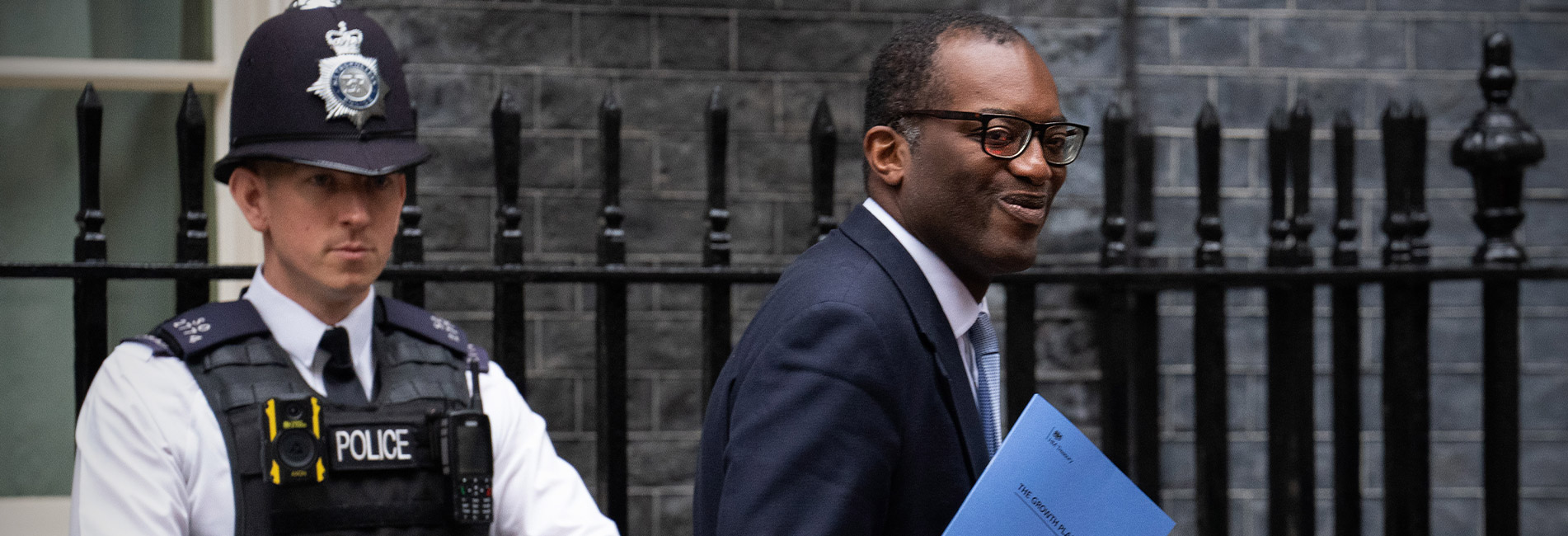
Growth trumps all in the super-sized mini-Budget
23 September 2022
The UK’s new chancellor of the exchequer, Kwasi Kwarteng, has delivered an emergency mini-budget that packs a punch. We look at what it could mean for you, your business and the economy.
This morning, Chancellor Kwasi Kwarteng presented his Fiscal Statement, dubbed the “Growth Plan”. Whereas this is not the Budget itself – indeed, Chief Secretary to the Treasury stressed that it is up to the Chancellor to determine whether there will be one before the end of the financial year – the measures contained in this ‘mini-Budget’ were anything but small.
This was in the name of the government’s ‘primary economic objective’, now spelt out explicitly to be to boost trend growth to 2.5%, vis-à-vis an average of 1.8% in the two decades prior to the pandemic. The bet is that this can be achieved by providing incentives through the tax system for increased investment and also for a step up in the supply of labour – and that ultimately the resulting boost to economic activity will generate enough tax revenue to fund the bulk or even all the foregone receipts.
To us, this seems a risky wager. It is not clear that, at a time of record-low unemployment and tighter immigration restrictions, there is much scope for boosting labour supply in this way. Nor is it evident that tax incentives will achieve the boost to investment that a prolonged period of ultra-low interest rates did not – especially as the latter has come to an end. This may well be reinforced by the Bank of England having to hike rates more aggressively to bring inflation back to target given tax cuts. Politically too, the public will need to see evidence that this strategy is working for it to pay dividends for the Conservative Party by the time of the next general election: a recent survey by the National Centre of Social Research showed a (narrow) majority of the population to be in favour of higher, not lower, taxes, in order to support more public spending on health, education and social benefits.
The initial verdict in financial markets of this minimaxi-Budget has not been favourable. Despite the Chancellor attempting to soothe fears in markets of how far the government was prepared to go with reforms, affirming explicitly today that the independence of the Bank of England was ‘sacrosanct’ and having previously reconfirmed the government’s commitment to the 2% inflation target, expectations for policy rates have shot up, as have longer-dated gilt yields. Indeed, at the time of writing, 2-year yields have surged by 42bps on the day, to 3.93%; and 10-year yields have rocketed by 28bp to 3.77%, now narrowly exceeding US 10-year Treasury yields. Similarly, in currency markets, sterling has responded with a far steeper selloff against the dollar than other major currencies (-1.8% to 1.105 in GBPUSD, against -0.8% to 0.975 in EURUSD).
The key measures in a huge fiscal easing
In a nutshell, the government committed itself to a huge fiscal easing, comfortably dwarfing the £97bn (c.4% of GDP) spent during the pandemic on furlough for employees and equivalent support for the self-employed taken together. This is to be funded by additional government borrowing: for 2022-23 alone, the DMO is to sell an additional £62.4bn of gilts and £10bn of Treasury bills. The list of measures announced is long; we discuss the main ones below. In summary, there are three elements that stand to be the most costly, and which had effectively been pre-announced:
- The energy package, comprising support to households and to firms. We have reviewed these previously (see here and here, respectively). For the first time, the government provided some estimates of costings – but only for the first six months of the schemes. Over this period, the government reckons on a cost of c.£60bn, with £31bn of that on household relief and £29bn on business relief, which is in addition to the c.£15bn cost of living support package announced by then-Chancellor Sunak in May. Yet the government is already committed to household-level relief to run for two years, and has indicated that support to (as yet-to-be-defined) ‘vulnerable’ non-domestic customers will be extended past the initial six-month period too. Our utility analyst estimates that the overall bill for household energy support over the full period could be close to £90bn and that for non-domestic consumers £22bn-£48bn.
- The reversal from 6 Nov of the National Insurance tax hike introduced by PM Johnson’s administration as of April 2022. Current costings by the government suggest this could forego c.£77bn in government revenues over the coming five fiscal years, of which c.£12bn could be covered by resulting higher wages and profits boosting the government’s tax take.
- The scrapping of the planned increase in corporation tax from 19% to 25% that was due to come into effect from April 2023. Again according to government costings, this is to result in c.£65bn less revenue to the government in the four financial years from 2023-24 to 2026-27.
In addition, there were some major ‘rabbits in the hat’, as is usual with a large fiscal event. Indeed, in attempting to cement Conservative credentials as the party of low taxes, Chancellor Kwarteng brought forward the reduction in the basic rate of personal income tax by one year relative to what was planned under Mr Sunak, to April 2023, at an extra cost of c.£5bn. On top of this, the country's highest earners will also benefit from the scrapping of the 45p additional rate of income tax from next April, currently paid by those with earnings above £150,000 a year. There are also planned changes to stamp duty tax. Relative to the cost of some of the other measures, this was fairly small, with the threshold from which stamp duty must be paid by all buyers doubled to £250k, whilst for first-time buyers the threshold was raised from £300k to £425k on the value of a property up to £625k (previously: £500k). Other measures announced include the freezing of alcohol duty for one year from February 2023 and VAT-free shopping for overseas visitors.
A final major announcement from the Chancellor was with regards to investment zones, which have been dubbed by others as 'freeports with rocket boosters'. The new investment zones will be special areas of the country that benefit from tax incentives and easier planning restrictions for a period of ten years, to shore up growth in the area. Although the details are thin – no costings are provided as full details are yet to be determined – the tax incentives under consideration include 100% business rate relief on newly occupied business premises and a scrapping of employer NICs on earnings up to £50,270 of any new employee working in the investment zone. The Chancellor revealed the government to be in early discussions with nearly 40 areas regarding establishing such investment zones.
And that is not all
The major caveat is that, when compiling the costings for these, the Treasury generally relied on assumptions made by the OBR at the time of the Spring Statement 2022 (23 March 2022). Since then, the economic environment has changed substantially, not least as Europe’s energy costs have spiralled as Russia severely curtailed supplies of natural gas to the continent. This naturally leaves the economic scenario outlined then very outdated. However, the Truss administration has declined to seek new OBR projections and a full assessment of its policies announced to date, deferring this until later in the year. Given the complexity and sheer number of the measures outlined, markets for one would probably have welcomed an independent assessment of the measures outlined today. Comments by the Chief Secretary to the Treasury suggest that such an assessment may not be made until December.
At that point, the Chancellor’s statement hints, there may be a number of other substantial reforms to take into consideration. Mr Kwarteng suggested a financial sector deregulatory package was in the works, to be unveiled later this autumn, a key feature of which is to scrap EU rules under Solvency II to help boost investment. Also, by the end of 2022, the government has commissioned a report on how to deliver the government’s net zero commitment while maximising growth, supporting energy security and minimising the cost to businesses and consumers. To aid labour supply, there was also talk of bringing forward reforms to improve access to affordable, flexible childcare, as well as of new plans for the immigration system to support growth. Details of such supply side reforms could potentially have a significant bearing on the outlook as well.
Generally, though, for now the government’s express hope is that, through the stimulus put on the table immediately, the economy will be able to avoid a ‘deep and damaging’ recession in the near term, thereby supporting the fiscal position and lowering debt servicing cost. Implicitly, it must also hope that the promise of an ‘update’ on its medium-term fiscal plan ‘at the next fiscal event’ will suffice to reassure markets regarding the commitment of the new administration to medium-term fiscal sustainability. The market reaction today may be a reminder that maintaining and nurturing credibility is of the essence lest spiralling borrowing costs constrain the government’s room for action. How the relation with the Bank of England and its inflation fight is managed in the context of huge fiscal stimulus will be a key component of that in the months to come.

UK businesses will also benefit from an energy price cap
21 September 2022
In a much-awaited announcement today, the UK government provided more details on the support it is offering to non-domestic energy consumers to address spiralling energy costs, via a press release on the BEIS website. In essence, the government decided to mirror the household-level utility price cap for businesses, charities and public-sector organisations, for an initial six months from 1 October. At the same time as giving relief and greater predictability for firms to tie them over a particularly challenging period this winter, this comes with what could be a significant price tag.
Because non-domestic energy contracts are bespoke, with no equivalent to the Ofgem household-level price cap already in place, the cap is applied to the wholesale per-unit element of gas and electricity prices that is embedded in individual contracts. For fixed contracts (agreed since 1 Apr 2022) these ‘government supported prices’ will be set at £211/MWh for electricity and £75/MWh for gas – substantially below current winter wholesale prices, which the government suggests are around £600/MWh for electricity and £180/MWh for gas. End user prices will still vary according to individual contracts, depending on network charges, operating costs and distributors’ profit margins. Businesses are encouraged to consider switching to fixed contracts, but should they wish to remain on variable, deemed or other contracts, those too will be reduced, with a maximum discount relative to wholesale prices of around £405/MWh for electricity and £115/MWh for gas (the exact figures will be set on 30 Sep, i.e. the day before the scheme begins).
As previously trailed, the blanket energy support scheme for non-domestic users applies for six months. In the interim, it is hoped that energy market reform to decouple electricity prices from gas prices will help to lower bills. To what extent that will counter what could still be very high pressures in global energy markets is, however, highly uncertain. The operation of the scheme is to be reviewed in three months’ time, ‘to inform decisions on future support after March 2023’. Thereafter, there is supposed to be continued support for certain, as yet to be determined, ‘vulnerable’ non-domestic customers. How wide that net will be cast will be a key question for many firms in the coming months – the wider, the less distortive, but also the more expensive.
As with the household-level support package outlined by PM Truss on 8 September, today’s announcement contains no estimate of its expected costings. Seemingly, official government estimates will have to wait until the Fiscal Statement, which is anticipated to come this Friday (23 Sep). Even so, ultimately such predictions will be very uncertain. By committing itself to plug the gap between (highly volatile) market prices and a fixed end user per-unit cost from public funding, effectively the government is writing an option, and the final bill of the package cannot be known in advance but will depend on the evolution of actual gas prices, as well on the quantity of gas consumed. In this respect, the government gave nods to non-domestic users that they should ‘use the 6 month support provided by the scheme to identify measures they can take to protect themselves against high energy prices’ – only the lightest of encouragements towards energy-saving measures, and certainly a far cry from the clear numerical targets set in the EU for reducing gas demand.
In the absence of official numbers, our utilities team tentatively suggest a range of £22bn-£48bn as a cost for the non-domestic energy support package over its initial six-month period. Adding this to what may be a price tag of close to £90bn for household energy bill support, as per our utilities analyst, it is clear that the government is prepared to commit substantial amounts of government funding to provide support with surging energy prices. To put these figures into context, furlough for employees and the self-employed cost £97bn, close to 4% of GDP.
Helpful in this respect will have been the news earlier this morning that, although net borrowing by the public sector in August 2022, at £11.8bn, exceeded forecasts (consensus £8.1bn, Investec £9.6bn), the trend of downward revisions to previous borrowing estimates was maintained. Indeed, borrowing for the fiscal year that ended in March is now estimated as £134bn, some £10bn less than reported last month; and borrowing for the financial year up to July is now said to be £9bn lower than previous data had indicated.
This will have been welcome news to the Chancellor, who is reportedly preparing to lay out a series of additional fiscal easing measures later this week. On top of the energy support packages for households and non-domestic users, a reversal of the national insurance tax hike, the scrapping of the planned corporation tax rise and some cuts in stamp duty too are said to feature in his plans. The costing of these, however, will not be subject to OBR scrutiny on this occasion, with an OBR assessment deferred until later in the year. The direction of travel, however, is clear: even with the help from lower past borrowing than initially reported, it will be very difficult to remain on the path of improving public finances for long. And, although the immediate risk of recession over the coming winter is diminished, substantial fiscal stimulus adds to the risk of high inflation being maintained for longer – and hence the chances of, ultimately, substantially more policy tightening by the Bank of England being required.
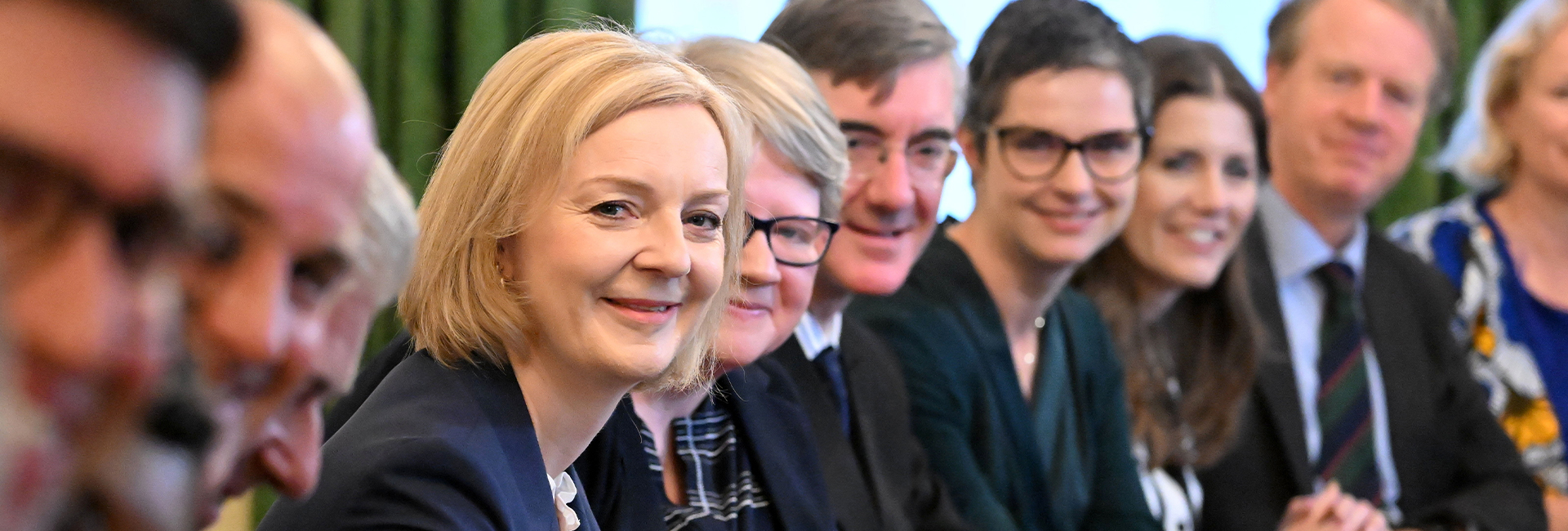
UK energy bill: generous but costly
8 September 2022
Today, three days into her new role as Prime Minister, Liz Truss announced the much-awaited package of help for households and businesses grappling with surging utility bills.
Much as previous press reports had suggested, the package for households will entail a freeze of bills at the typical level of consumption at £2,500 per year from 1 October. (It is important to bear in mind that what is being frozen is the unit price of energy for households, whereas actual bills will also change with consumption.) This is well below the rise in the price cap to £3,549 that Ofgem had calculated would have been necessary in October to reflect the past surge in wholesale market prices for gas and electricity. But in subsequent quarters, market prices would likely have necessitated much higher bills still. Our utilities analysts estimate that, for the first year of the cap, the cost to the government will equate to about £54bn, with a lower price tag than this for the second year. A total cost of £90bn-£100bn or so for the household bill freeze, as prior press reports had suggested, therefore seems close to the mark. This estimate, however, will naturally change with gas prices, which have been extremely volatile. Indeed, notably Ms Truss deferred putting a number onto it until the emergency Budget, or fiscal statement, by Chancellor Kwarteng later this month.
This is not the entirety of the support given to households: for those not benefitting from the energy price cap – e.g. those using heating oil or heat networks – a fund with equivalent support will be set up. Moreover, PM Truss confirmed that the universal £400 rebate per household that Rishi Sunak had announced in May will be preserved too, as will additional measures within that package targeted at vulnerable households. Finally, ‘green levies’ – environmental and social obligation costs – will temporarily be suspended; these currently account for £152 of the current Ofgem price cap (£1,971). So, in aggregate, household bills will be at similar levels from October as they are now.
As far as support for businesses is concerned, what PM Truss outlined today was much more sketchy – as well as more limited in its scope. She promised there would be an ‘equivalent’ unit price guarantee for all businesses for six months, followed by more targeted help for especially vulnerable sectors (hospitality was explicitly mentioned as one of these) after that. What that help would be, and which businesses would count as ‘vulnerable’, was left to be determined in a review, to be concluded within three months. Nor was it said at what level the unit price for businesses will be fixed, nor what the estimated cost of the package pencilled in by the government would be. A preliminary suggestion by our utilities team is that it could be around £30bn or so.
From the point of view of inflation, the outlined package will make a material difference to the outlook. Our indicative preliminary estimate is that, with it, headline CPI inflation will peak at c.10¼% in October rather than the 13½% we would have expected with a £3,549 energy price cap, and head lower from there, avoiding a further sizeable rise in January. This will provide significant support to household purchasing power. Given the amount of fiscal firepower used, that is not surprising: the furlough scheme itself cost £69bn and the scheme for the self-employed a further £28bn, nearly 4% of GDP in total – and the household scheme seemingly comes close to that again.
As regards public finances, we will have to await the details in the upcoming fiscal event by Chancellor Kwarteng later this month. (Whether or not this will come with an OBR assessment is as yet unclear.) But the broad outline is that, with additional windfall taxes (beyond those introduced by Mr Sunak in May) categorically ruled out by PM Truss – drawing a clear dividing line between her and what Labour leader Keir Starmer had called for – it is government borrowing that will pick up the tab for today’s huge energy support package. The near-term net cost to the public purse will not be quite as large as the sum of the figures outlined above, because lower inflation will also result in lower interest payments on government debt. But of course, a higher level of government debt will, over time, require additional expenditure on debt interest.
Giving immediate help to households and businesses had become a political necessity to which Ms Truss has bowed, notwithstanding her avowed dislike for ‘handouts’ that she had expressed earlier during the leadership race. Alongside her package of help for households and businesses, she listed several longer-term policies to improve energy security and affordability and restructure energy markets. Chief among these is a plan to ramp up the domestic supply of energy, through extra licensing for exploration of North Sea fossil fuel resources, but also faster deployment of clean technologies, given her stated ‘complete commitment’ to net zero by 2050. Indeed, the PM expressed her ambition that the UK should become a net exporter of energy by 2040, which is a bold goal indeed considering that, as of 2021, net imports met 38% of the country’s inland primary energy consumption. As regards affordability, a switch to long-term CfD for renewables and nuclear power generation is on the cards, which Ms Truss noted would also go towards lowering the cost of today’s intervention.
In general, through today’s package, PM Truss will have allayed fears that households will face an impossible challenge for many in meeting bills this winter. This will no doubt make for a much less bleak near-term outlook for inflation and for growth. Indeed, the risk of recession due to this appears diminished although not necessarily extinguished. But, as she acknowledged herself, there are no cost-free options. The path chosen is an expensive one – and one that gives no incentives to households to scale back on energy consumption relative to now. This could pose challenges in itself in the context of reduced availability of energy in Europe over the winter. And, by keeping demand stronger than it would otherwise be, today’s announcement strengthens the argument that medium-term inflation risks have increased. The Bank of England is likely to take note when setting policy rates: a higher peak in the Bank rate may well result. Much, however, will depend on the wider fiscal stance unveiled at the mini-Budget later this month.
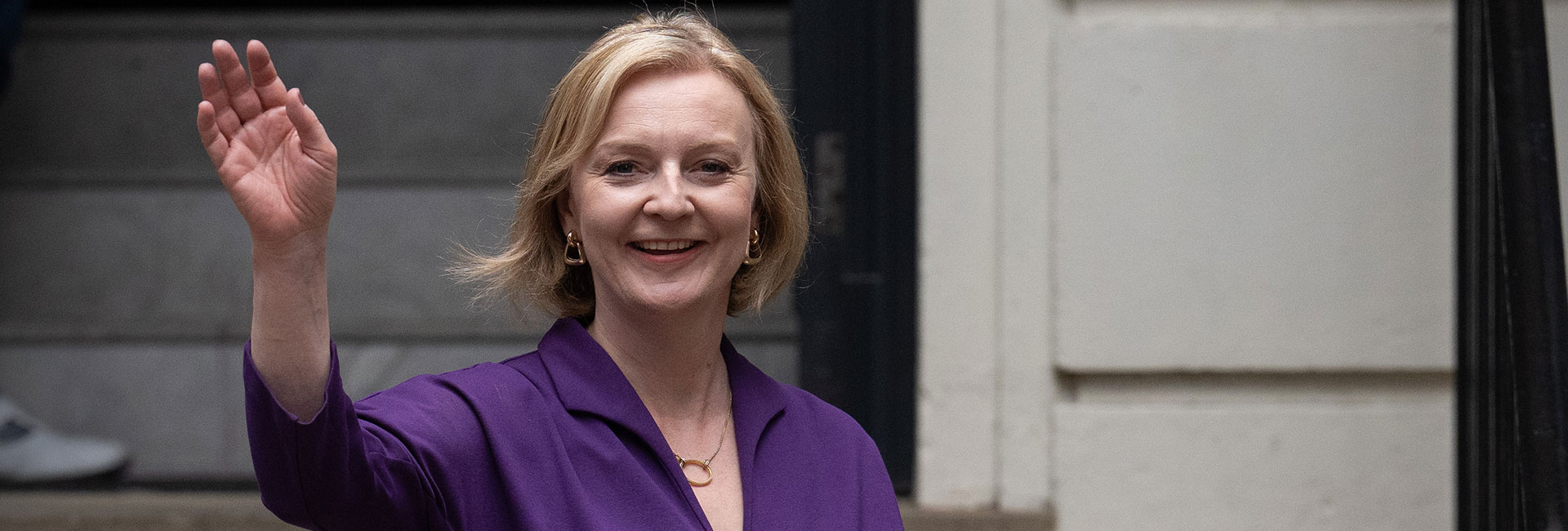
Liz Truss to succeed Boris Johnson as UK prime minister
5 September 2022
Results from the Conservative party leadership contest showed that Foreign Secretary Liz Truss beat her rival Rishi Sunak by a margin of 15%. While the former Chancellor had the support of a greater number of Conservative MPs, his relative popularity did not extend to the party membership as a whole. Of course what will matter in due course will be the new PM’s popularity with the entire UK electorate. However the next general election may not take place for two years or more.
In terms of procedures, Ms Truss will visit the Queen at Balmoral Castle tomorrow where she will be appointed as Prime Minister. It is thought that the new PM will announce her Cabinet on Wednesday. That said, a number of leaks may already have given us some clues as to its composition.
Ms Truss will undoubtedly face the toughest in-tray of any incoming UK Prime Minister in recent history, including foreign and trade policy. Ms Truss has acted as Secretary of State in both areas. But it is of course economic policy that finds itself in the eye of the storm. In particular, energy prices will require the most urgent attention, specifically the 80% increase in the domestic price cap due in October (and a likely material increase on top of this in January). While the need to relief to households has been the highest profile issue, we would note that many firms are facing even steeper price hikes given that businesses’ energy costs are not capped.
Recent press stories suggest that the government will introduce an energy price freeze. As yet this has not been confirmed, nor at what price the cap might be frozen and for how long. The reports however point to a choice between two structures. In the first, the government will refund energy companies to make up the shortfall with market rates. In the second, banks will provide loans to energy providers to hold bills down temporarily, and the government will underwrite the loans; these would then be repaid over a long time horizon in instalments, with these added onto future customer bills. Our suspicion is that the package will contain a considerable element of government subsidy. As we have written before, this would be expensive. Illustratively, a total freeze at current levels (i.e. offsetting October’s 80% rise) for a year would cost £44bn. This disregards the cost of offsetting any increases in the cap that would otherwise have taken effect in January, April or July next year. Nor does it deal with businesses. By comparison the cost of the furlough (CJRS) scheme was £69bn.
A formal freezing of the energy cap would be likely to be treated as a price reduction and therefore impact on inflation as it is measured by the ONS. This is in contrast with the existing system of payments introduced by Rishi Sunak to address April’s 54% rise, which is formally classified as an income subsidy. Our current forecast is that CPI inflation will peak at 13.5% this October and in January next year. On the example above, freezing energy prices at current levels for a year would result in a much lower inflation profile. On this profile inflation is currently at its peak at 10.1% and would ease back to 8.6% in January.
Ms Truss’s preference for tax cuts means that it is also likely that there would be an emergency Budget, possibly on 21 September. At present we cannot say for sure what the new Chancellor will pick from the new PM’s wish list. But again as an example, cancelling next April’s 6p increase in Corporation tax and reversing last April’s 1.25p hike in National Insurance Contributions would together cost £29bn. Together with the illustrative energy relief cost mentioned above, the total would come to £73bn, or 3% of GDP. This is before any other reductions that might be on the cards.
Our view has been that a scheme to provide households and businesses with relief from surging energy costs would be entirely justified. However we have already written on the dangers of a significant general fiscal expansion at this stage, both from the perspective of the position of the public finances and from fiscal policy pushing in the opposite direction to monetary policy. If these events were to unfold as we have set out above, the Bank of England would be probably be of a mind to raise rates further for longer. However details of the new economic policy will be necessary for it make a judgement.

A (seemingly) strong and broad-based rebound in UK GDP in May
13 July 2022
UK monthly GDP figures for May surprised firmly on the upside, reporting a large and broad-based rebound in real economic activity: notwithstanding the cost-of-living surge and intense price pressures for inputs, GDP increased by 0.5% on the month (consensus: 0.0%, Investec -0.2%). Moreover, there were upward revisions to the back data too, with March and April numbers 0.2%pts and 0.1%pts higher than previously reported, respectively.
The details of the report reveal human health and social work activities to have been an important driver of aggregate output growth, its 2.1% increase accounting for 0.2%pts of monthly GDP growth. This reflects a surge in GP appointments, which was large enough to more than offset a fall in NHS Test and Trace and Covid vaccinations (which in itself subtracted 0.2%pts from output). But the overall picture is that output gains were broad-based, with manufacturing posting its largest monthly rise since November 2020 (+1.4%), construction jumping by 1.5%, and even consumer-facing services down only 0.1%, as clearly weaker spending on sports activities and amusement and recreation activities (-5.3%) and lower retail sales (-0.5%) were largely offset by a surge of 11% in travel-related services. This is consistent with an uneven picture of spending across the income distribution: whereas some parts of consumer spending are evidently suffering, others are still benefitting from pent-up demand and the high stock of savings to fund it. In other words, for the time being, there is little sign that the cost-of-living crisis, coupled with the National Insurance Contributions hike, has caused an aggregate spending crunch, consistent with a degree of resilience of total consumer spending.
One caveat to bear in mind is that the shift in the timing of the Bank Holiday that usually takes place in May to early June this year as part of the Platinum Jubilee celebrations may not have been accounted for accurately. Although an adjustment to strip out the effect of the extra working day was made, this may not have been complete. That GDP growth was quite so broad-based reinforces our doubts. The ONS itself acknowledged as much, noting that the timing of bank holidays ‘might lead to more volatile movements in the monthly path of GDP in May and June’. It is therefore possible that some of the reported strength in today’s data is reversed in the June numbers.
Looking ahead, we continue to see the squeeze from higher prices and also rising interest rates as likely to build. A particular pinch point remains energy; utility bills look poised for a percentage rise in October of a similar magnitude as in May, which is more than what had been factored in when the government put together its revised support package to households in late May. Given the resilience of the economy so far, and the potential for second-round effects in wage setting still looming large, the BoE may well see the case for ‘forceful’ policy action as reinforced by today’s data. As firms and eventually households respond to this, we expect the economy to tip into a technical recession around the turn of the year – likely prompting an about-turn in policy rates in due course later in 2023.
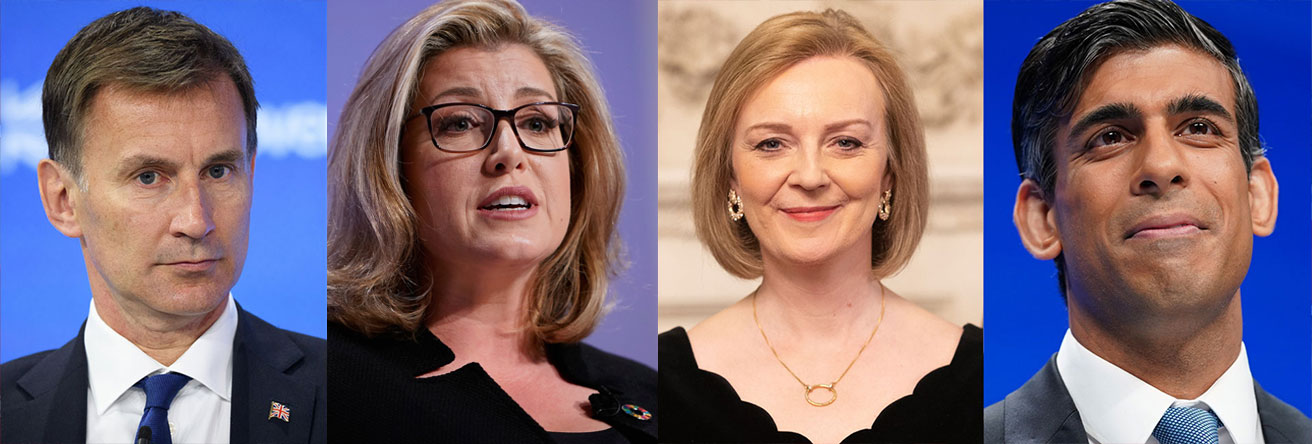
Race to succeed Boris hots up
11 July 2022
The number of Tory candidates who have so far declared their intention to run in the Conservative Party leadership contest to succeed Boris Johnson has reached ten and includes names such as Rishi Sunak, Penny Mordaunt, Jeremy Hunt, Liz Truss and Sajid Javid. Perhaps surprisingly the bookmakers' favourite last week, Defence Secretary Ben Wallace, has ruled himself out, stating his priority focusing on defence given the backdrop of the war in Ukraine. As of this morning oddschecker has Rishi Sunak as the favourite.
In terms of the process for the leadership contest, a meeting of the 1922 Committee later today will set out the terms of the election, in particular the number of supporting MPs a candidate must have in order to meet the threshold for running. Reports over the weekend suggest that the Committee want to whittle down the field quickly by setting a high threshold for entry. It had been suggested that it could be as high as 10% of the Parliamentary party, i.e 36 MPs, whilst a lower threshold of 20 MPs has also been mooted. After this, formal nominations are expected to open on Tuesday followed by the first round of voting on Wednesday, with the ultimate aim of having the final two candidates before Parliament goes into recess on 21 July and the intention, following votes in the summer by the grassroots party members of the party, to have a new PM take office on 5 September.
Given the backdrop of significant headwinds to the economy, tax cuts have been a primary campaigning tool of several candidates. For example Jeremy Hunt has pledged an immediate cut in corporation tax to 15p, whilst Javid has argued for a 1p cut per year, plus a reversal of the national insurance rise. The majority of the remaining candidates have also argued for lower taxes, although the odd one out is former Chancellor Rishi Sunak, who has continued to argue for more responsible fiscal policy. One read across from this is that if any of the tax cut-backing candidates win the election the more expansionary stance of fiscal policy could lead to the BoE having to tighten monetary policy more aggressively as it battles continued high levels of inflation.
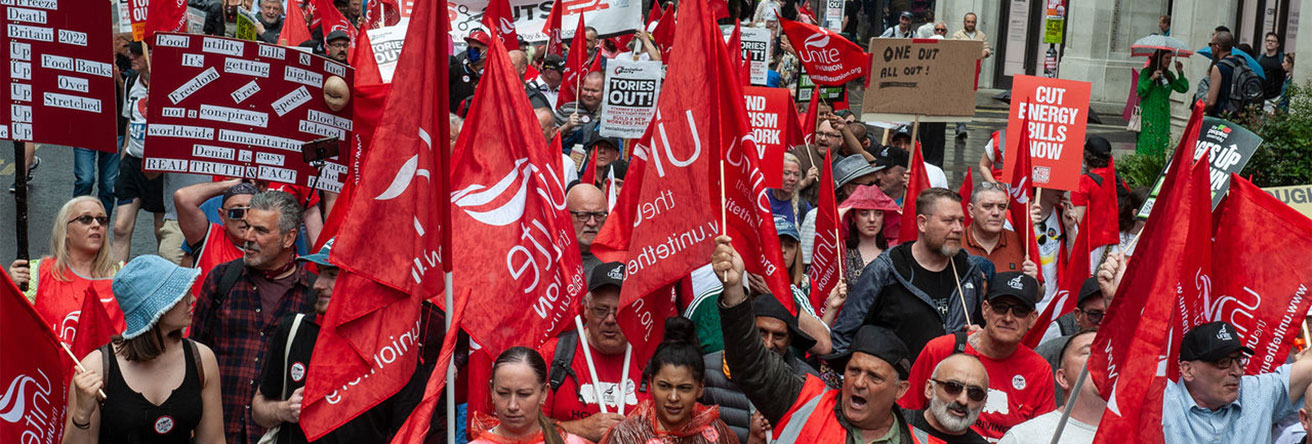
More evidence of wage pressure in the UK
08 July 2022
Trade union Unite announced that it had agreed a ‘vastly improved’ pay deal with British Airways, leading to a suspension of the threat of strike action by check-in staff at London Heathrow. BA has also struck a deal with the GMB union, again averting industrial action by its members. Certainly specific factors in the airline industry played a part in this.
Strike action, or the threat thereof, is by no means confined to this sector, however – the rail industry, criminal barristers, teachers and others are in similar positions. Resolving pay disputes in the public sector may be particularly challenging in the UK currently, in the political vacuum that has ensued following the resignation of Boris Johnson as Prime Minister. The broader picture is that of a very tight labour market, which increases the bargaining power of employees when it comes to securing some compensation through pay for the surge in the cost of living. Firms, however, may not be able or willing to absorb this without passing on cost increases through to the consumer level – in turn prolonging and extending the inflationary impulse.
This is troublesome for the Bank of England and may lead to further interest rate rises to cool demand more decisively. But effects may be broader still: in the NHS, the CFO of NHS England has suggested that each percentage point above 3% in pay settlements would cost £900m-£1bn. In the absence of more money being made available by the Treasury to cover this, cuts to services would have to be made that would compromise care, including for cancer. A difficult period lies ahead: we anticipate a mild recession in the UK around the turn of the year, albeit one that – not being a financial crisis – is certainly not as deep as the global financial crisis.
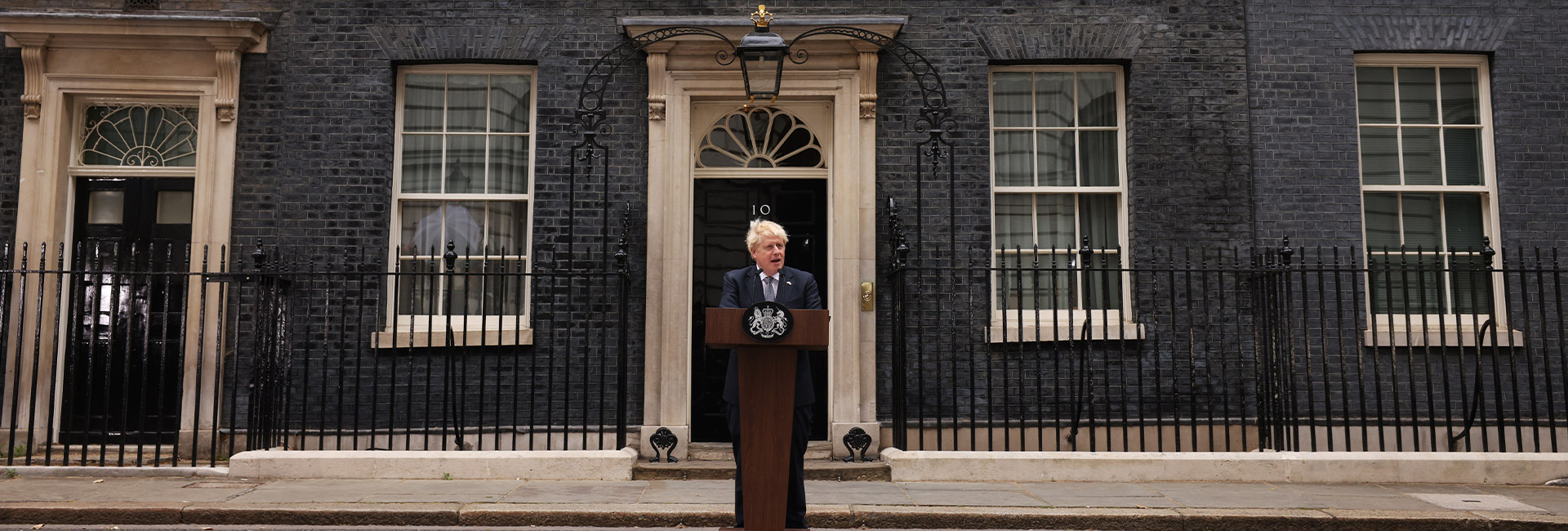
Sterling rises despite political vacuum as Johnson resigns
07 July 2022
After a dramatic few days in UK politics, our Economics Team looks at who could replace Boris Johnson as prime minister and what that might mean for government policy.
In Ernest Hemingway’s The Sun Also Rises, a character, when asked how he went bankrupt, replies, “Two ways. Gradually, then suddenly.” Much the same can be said to describe how Boris Johnson’s position as UK Prime Minister ended. After what can be politely described as two days of utter domestic political chaos, PM Boris Johnson signalled his intention to resign earlier this morning. He intends to remain in situ at 10 Downing Street as caretaker prime minister until a replacement is chosen.
The next stage will be for the Conservatives to elect a new leader. The process is that Conservative MPs vying for the leadership need to declare their candidacy. Then all Tory MPs will eliminate the contenders one by one in successive rounds of voting until two remain. After a campaign, there will be a head-to-head vote among grassroots party members to select the leader. The timetable for the rounds of voting among MPs will be announced next week and, depending on the number of candidates, should be completed relatively quickly. However, the membership vote will not likely to be concluded until autumn.

Boris Johnson to resign as UK prime minister
07 July 2022
In contrast to the line pursued yesterday, it is now expected that Boris Johnson will resign as Prime Minister of the UK today. Several further ministerial resignations have been announced this morning, including Michelle Donelan, appointed as Education Secretary just 36 hours ago. Meanwhile, Nadhim Zahawi, the newly appointed Chancellor, publicly called for the PM to leave office. Staff inside 10 Downing Street have reportedly spoken with Mr Johnson, and a resignation letter is now believed to have been prepared.
Boris Johnson will make a public statement, expected around lunchtime, to formally announce his resignation. The question now is who takes over in the interim, while a new Conservative leader is chosen - a process which could take months. It is understood that Boris Johnson would prefer to stay on as caretaker, but MPs seem to be in favour of another line. It now looks more likely that Deputy PM Dominic Raab will take over in the meantime, and most ministers will be reappointed to their respective positions for the summer. Later today, we will publish a full note on both the resignation and the outlook going forward.

UK Prime Minister Boris Johnson on the brink
07 July 2022
Turmoil in UK Prime Minister Boris Johnson’s government has broadened. Mr Johnson has so far refused to resign from his position. This is notwithstanding the resignation of 50 ministers at the latest count – started by that of Chancellor Rishi Sunak and perhaps most significantly Health Secretary Sajid Javid, but now extending to others from within Cabinet such as, as of this morning, Northern Ireland Secretary Brandon Lewis as well as a string of more junior ministers and PPS. Even among those that have not tendered their resignation, many of those previously loyal to Johnson such as Home Secretary Priti Patel, Business Secretary Kwasi Kwarteng and Attorney General Suella Braverman – as well as newly appointed Chancellor Nadhim Zahawi and new Education Secretary Michelle Donelan – are said to have entreated Mr Johnson to resign. A similar call by Levelling Up Secretary Michael Gove has been met by him being sacked.
The situation remains in flux, but reports are that Mr Johnson has threatened his colleagues with early elections to deter them from ousting him, although he subsequently denied this when questioned in the Liaison Committee. Should Mr Johnson continue to refuse to leave office, the elections to the 1922 Committee of backbench MPs on Monday will give an opportunity to the new committee, should they so decide, to change the rules that currently prevent a second no-confidence vote in the Prime Minister within a year of the previous one and theoretically leave Johnson safe in his job until June 2023. The expectation is that Mr Johnson would lose such a vote if a re-run were held before the summer recess that starts on 21 July. Whereas that seems very plausible to us, this is not entirely certain, given that it is not clear how many of those who have currently resigned from government, and of MPs who have publicly announced they have sent letters of no confidence in the Prime Minister to Sir Graham Brady, the Chair of the current 1922 Committee, already voted against Mr Johnson at the previous no confidence vote. However, the Telegraph reports that Tory Whips estimate just 65 MPs would back the PM in a second vote.
Notwithstanding the current political turmoil, sterling has trended up since yesterday morning. A factor behind that may be that, under a new leadership, the possibility of a more conciliatory stance regarding the Northern Ireland Protocol opens up, and chances of Scottish independence may also recede. Both, however, will depend on how the situation is resolved – and on who, if anyone, eventually becomes the new Prime Minister.

UK prime minister under pressure as resignations continue
06 July 2022
Following the resignations of Rishi Sunak and Sajid Javid from their ministerial posts last night, Conservative MPs have continued to withdraw their support for Prime Minister Boris Johnson this morning via further resignations and submission of letters of no confidence. Mr Johnson survived a vote of confidence one month ago today, winning by a margin of 211-148, but given the latest developments, it is likely that the PM would not survive another.
Under the current party rules, another vote of no confidence in the Prime Minister may not be held for twelve months. However, there has been speculation about changing this rule to allow a second vote sooner. Previously it was expected that this might only change following the elections to the 1922 Committee later this month, but political reporters are now suggesting that the current committee will meet at 5:00pm this evening to discuss amending the rules imminently. In this case, assuming the threshold of 54 letters of no confidence were met, another vote of no confidence in Boris Johnson could be held in the next week. It is looking increasingly likely that the UK will have a new Prime Minister in the not-too-distant future. Boris Johnson is now making his way to the House of Commons for PMQs at 12:00pm.

UK Chancellor and Health Secretary resign
06 July 2022
UK Prime Minister Boris Johnson suffered another blow yesterday when Rishi Sunak and Sajid Javid both resigned from their posts within minutes of each other. A number of other junior ministers also quit, including Alex Chalk, the Solicitor General. Mr Johnson looks even more vulnerable now, especially with the elections to the Conservative backbench 1922 Committee taking place next week. A new committee could potentially change the rules to enable a challenge to Mr Johnson's leadership before June next year, as specified by the existing party rules - rumours suggest the possibility of another challenge even ahead of the summer recess, which begins on 21 July.
A government reshuffle followed last night with Nadhim Zahawi taking over as Chancellor and Steve Barclay as Health Secretary. Typically political turmoil results in a sell-off in the currency, but markets were highly volatile yesterday and there was no major reaction by sterling. In any case, one might argue that a more likely departure of Mr Johnson, the chances of which have arguably risen, could result in a less confrontational approach to negotiations with the EU over the Northern Ireland protocol, reducing the risks of trade tensions with the 27 nation European bloc.
Browse articles in

